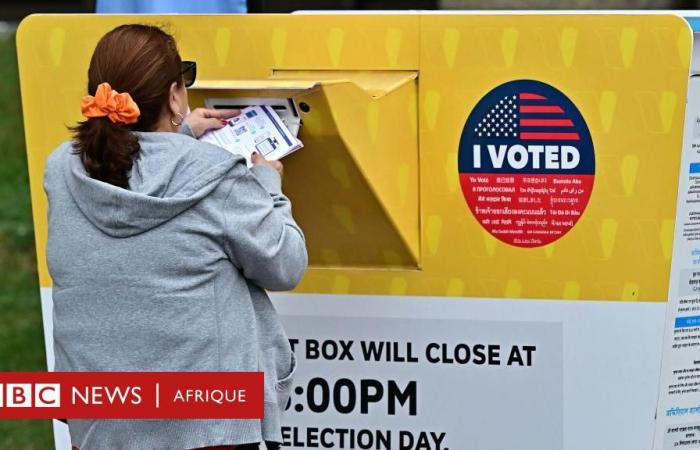Photo credit, Getty
- Author, Anthony Zurcher
- Role, Correspondent for North America
- Twitter, @awzurcher
- Reporting from Washington, DC
-
8 minutes ago
Never in recent U.S. political history has the outcome of a presidential election been so uncertain – this is not a contest for the faint of heart.
Although past elections have been narrowly decided – George W. Bush's victory over Al Gore in 2000 came down to a few hundred votes in Florida – there has always been an idea of where the race was heading in the past. last days.
Sometimes, like in 2016, that feeling is wrong. That year, polls overestimated Hillary Clinton's strength and failed to detect a late shift toward Donald Trump.
This time, however, the arrows all point in different directions. No one can seriously make a prediction one way or the other.
Photo credit, Getty
A game of heads or tails
Most of the latest polls are well within the margin of error, both nationally and in the seven key states that will decide the election.
Based on statistics and sample sizes alone, this means either candidate could be in the lead.
It is this uncertainty that unsettles political pundits and campaign strategists.
There have been some surprises, with a recent respected poll in Republican-leaning Iowa that gave Harris a sizable lead being a notable example.
But major polling averages and the forecasting models that interpret them all show it's a toss-up.
A clear winner is still possible
Just because the outcome of this election is uncertain doesn't mean the actual outcome won't be decisive – it only takes a few percentage points in one direction or the other for a candidate to sweep every state where they run. conduct the elections.
If voter turnout patterns are wrong and more women turn out to vote, or more rural residents, or more disaffected young voters, that could dramatically change the final results.
Surprises could also arise within key demographic groups.
Will Trump really succeed in winning over young black and Latino men, as his campaign predicted? Is Ms. Harris winning over a larger share of traditionally Republican women in the suburbs, as her team hopes? Do older voters, who vote regularly in each election and tend to lean to the right, move to the Democratic column?
Once this election is in the rearview mirror, we may be able to conclusively determine why the winning candidate came out on top.
In hindsight, the answer may be obvious. But those who claim to know how things will happen now are deceiving themselves.
Blue walls and red walls
In most American states, the outcome of the presidential election is practically certain. However, seven key battleground states will decide this election.
However, not all key states are equal. Each candidate has a three-state “wall” that offers them the most direct path to the White House.
Harris's “blue” wall, named after the color of the Democratic Party, spans Pennsylvania, Michigan and Wisconsin in the Great Lakes region. It has been the subject of many political conversations since 2016, when Trump narrowly carried these three traditionally Democratic states on his way to victory.
Joe Biden flipped these states in 2020. If Ms. Harris can hold on to them, she won't need any other battlegrounds, provided she also wins a congressional district in Nebraska (which has a slightly different system for allocating votes to the electoral college).
This explains why she spent most of her time in these blue states during the final stretch of the campaign, with full field days in each of them.
On Monday evening, she held her final meeting in Philadelphia, Pennsylvania, at the top of the 72 steps leading to the city's art museum, which the fictional boxer Rocky, played by Sylvester Stallone, climbed in the film of the same name – before narrowly losing to his opponent, Apollo Creed.
Trump’s “red wall” runs along the eastern border of the United States. We talk about it less, but it is just as important for his electoral chances. It begins in Pennsylvania and extends south to North Carolina and Georgia. If he wins these states, he will win with two electoral votes, regardless of the outcome of the other battlegrounds.
That's why he's held five events in North Carolina over the past week.
What all these walls have in common is, of course, Pennsylvania, the biggest electoral battleground. Its nickname, the Keystone State, has never been more appropriate.
America's future at stake
The historical importance of this presidential election is sometimes lost in all this strategy and this electoral card game.
Harris and Trump represent two very different visions of the United States – on immigration, trade, cultural issues and foreign policy.
The president of the next four years will be able to shape the American government – including the federal courts – in ways that could have an impact for generations.
The American political landscape has changed profoundly over the past four years, reflecting the changing demographic makeup of both parties.
The Republican Party of a decade ago was very different from the populist party that Donald Trump leads today, which appeals more to blue-collar and lower-income voters.
The Democratic Party's base still relies on young voters and people of color, but it now leans more on the wealthy and college-educated.
Tuesday's results could provide further evidence of how these tectonic shifts in American politics, which have only been partially realized over the past eight years, are reshaping the political map of the United States.
And these changes could give either side an advantage in future races.
Not long ago, in the 1970s and 1980s, Republicans were considered to have an unassailable lock on the presidency because they consistently won a majority in enough states to prevail in the Electoral College. .
This election may be a 50-50 contest, but that doesn't mean it's the new normal in American presidential politics.






